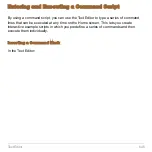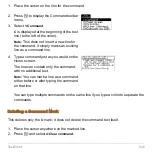
Numeric Solver
651
Refer to a function or equation
defined elsewhere.
Notes:
•
Do not use system function
names (such as
y1(x)
or
r1(
q
)
)
as simple variables (
y1
or
r1
)
.
•
Be careful with implied
multiplication. For example,
a(m2+m1)
is treated as a
function reference, not as
a
†
(m2+m1)
.
Suppose you defined
y1(x)
on either
the:
•
Y= Editor:
y1(x)=1.25x
†
cos(x)
– or –
•
Home screen:
Define y1(x)=1.25x
†
cos(x)
In the Numeric Solver, you then would
enter:
y1(x)=0
or
y1(t)=0
, etc.
Type an expression without an =
sign.
Note:
When you define the
variables, you can either define
exp
or solve for it.
e+f
N
ln(g)
After you press
¸
, the expression
is set equal to a system variable called
exp and entered as:
exp=e+f
N
ln(g)
Recall a previously entered
equation or open a saved
equation.
Note:
After you press
¸
the
current equation is stored
automatically to the system
variable
eqn
.
Refer to the applicable heading later in
this section.
You can:
For example:
The argument does
not have to match
the one used to
define the function
or equation.
Summary of Contents for Titanium TI-89
Page 9: ...Getting Started 6 TI 89 Titanium keys Ë Ì Í Ê ...
Page 34: ...Getting Started 31 2 or D 2 B u s i n e s s D B D B Press Result ...
Page 43: ...Getting Started 40 3 0 D B D D B D Press Result ...
Page 44: ...Getting Started 41 D 2 0 0 2 D B Scroll down to October and press Press Result ...
Page 58: ...Getting Started 55 Example Set split screen mode to TOP BOTTOM Press Result 3 B D ...
Page 70: ...Getting Started 67 ...
Page 175: ...Operating the Calculator 172 From the Keyboard ...
Page 456: ...Tables 453 ...
Page 527: ...Data Matrix Editor 524 ...
















































